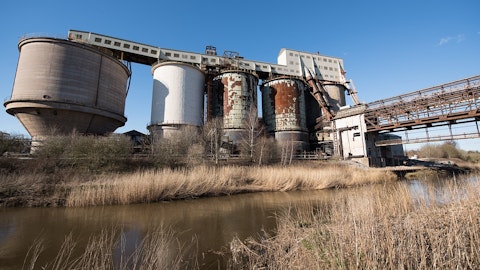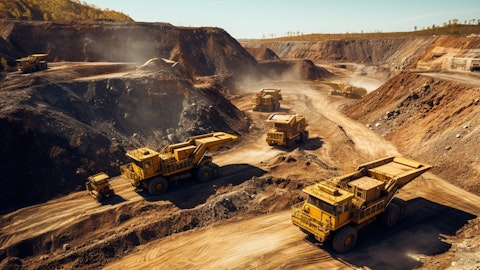LyondellBasell Industries N.V. (NYSE:LYB) Q3 2023 Earnings Call Transcript October 27, 2023
Operator: Hello, and welcome to the LyondellBasell teleconference. At the request of LyondellBasell, this conference is being recorded for instant replay purposes. [Operator Instructions] I’ll now turn the conference over to Mr. David Kinney, Head of Investor Relations. Sir, you may begin.
David Kinney: Good day, everybody, and thank you all for joining today’s call. Before we begin the discussion, I would like to point out that a slide presentation accompanies today’s call and is available on our website at www.lyondellbasell.com/investorrelations. Today, we will be discussing our business results, while making reference to some forward-looking statements and non-GAAP financial measures. We believe the forward-looking statements are based upon reasonable assumptions, and the alternative measures are useful to investors. Nonetheless, the forward-looking statements are subject to significant risk and uncertainty. We encourage you to learn more about the factors that could lead our actual results to differ by reviewing the cautionary statements in the presentation slides and our regulatory filings, which are also available on our Investor Relations website.
Comments made on this call will be in regard to our underlying business results using non-GAAP financial measures, such as EBITDA and earnings per share, excluding identified items. Additional documents on our Investor website provide reconciliations of non-GAAP financial measures to GAAP financial measures, together with other disclosures, including the earnings release and our business results discussion. A recording of this call will be available by telephone beginning at 1:00 p.m. Eastern Time today until November 27, by calling (877) 660-6853 in the United States and (201) 612-7415 outside the United States. The access code for both numbers is 13739196. Joining today’s call will be Peter Vanacker, LyondellBasell’s Chief Executive Officer; our CFO, Michael McMurray; Ken Lane, our Executive Vice President of Global Olefins and Polyolefins; Kim Foley, our EVP of Intermediates & Derivatives and Refining; and Torkel Rhenman, our EVP of Advanced Polymer Solutions.
During today’s call, we will focus on third quarter results, current market dynamics, our near-term outlook and our long-term strategy. With that being said, I would now like to turn the call over to Peter.
Peter Vanacker: Thank you, David, and welcome to all of you. We appreciate you joining us today as we discuss our third quarter results. Starting with Slide 3. We have three key messages for today’s call. First, LyondellBasell continues to generate resilient results despite challenging market conditions. Our team delivered exceptional cash conversion during the quarter. And our balanced approach to capital deployment was on full display, as we repaid maturing bonds, funded investments to grow and maintain our assets and rewarded shareholders through dividends and share repurchases. At the same time, thanks to great teamwork, we were able to bolster the cash on our balance sheet. Secondly, we remain focused on executing our long-term strategy.
You will recall that our strategy is built on three pillars. The first pillar reflects our commitment to actively grow and upgrade the core businesses that are aligned with our long-term strategy. We are growing our Intermediates & Derivatives segment through the successful start-up of our new PO/TBA facilities, the largest single train propylene oxide plant in the world. In the third quarter, extremely strong margins for oxyfuels produced from our PO/TBA assets contributed to a record-setting quarterly EBITDA for our Intermediates & Derivatives segment. Kim will provide more details on this in a few minutes. The other half of growing and upgrading our core involve difficult decisions about businesses and assets that do not really fit with our long-term direction.
In September, we announced our intent to close one of our two polypropylene production units in Brindisi, Italy. And our plans to exit the refining business and transform the site are very well known. These actions are examples of how the pillars of our strategy reinforce each other. We’re actively managing our business portfolio to reallocate resources toward assets and businesses that support the growth of our core, while building the second pillar of our strategy, a profitable circular and low-carbon solutions business. We continue to make good progress in this area, producing and marketing over 250,000 ton-site of recycled or renewable-based polymers since 2019. As Jim Seward and Yvonne van der Laan discussed in our MoReTec webinar last month, we’re looking forward to a final investment decision later this quarter on our first commercial advanced catalytic recycling plant in Germany.
And we are not sitting still, in just the past few weeks, we’ve announced joint ventures in two different Dutch plastic waste recycling companies, a stake in a circular plastic venture capital fund and a joint venture in infrastructure and recycled plastic feedstock’s that support our plans for an integrated circular and low-carbon solutions here in Houston and also a renewable electricity supply agreement in Spain. Our value enhancement program aligns with the third pillar of our strategy, stepping up our performance and culture. I am pleased to announce that our VEP is on track to exceed our target for $200 million in recurring annual EBITDA run rate by the end of 2023. As a reminder, last quarter, we increased our VEP target by $50 million, from our initial target of $150 million that we announced at our Capital Markets Day in March.
The new phone value unlocked by the VEP supports our investments to grow our core, while building a profitable and game-changing circular and low-carbon solutions business. My third key message is that LyondellBasell’s focused strategy is strengthening our business portfolio to ensure our company is well positioned to capture value today and into the future. Our track record of effective cost management, operational excellence and innovation all provide competitive advantages. With a sharper focus on core businesses that benefit from leading positions in growing markets with attractive returns, we can maximize the impact of these competitive advantages. I hope you share our excitement for the future of LyondellBasell. Let’s turn to Slide 4 and begin the discussion with our foundational commitment to leadership and safety performance.
Safe operations are fundamental to our core values and provide the cornerstone for our future success. LyondellBasell’s year-to-date incident rate for employees and contractors is 0.14, which means that our safety performance remains above the top 75th percentile for our industry. I want to congratulate our team for their outstanding safety performance. Let’s turn to Slide 5 and summarize our financial results. During the third quarter, LyondellBasell’s businesses delivered resilient results and strong cash generation from our well positioned and diverse portfolio. Earnings were $2.46 per share. EBITDA was $1.4 billion. At the end of the quarter, our cash from operating activities was $1.7 billion, with $7 billion of available liquidity. Now let me turn the call over to Michael first, and then to each of our business leaders, who will describe our financial and segment results in more detail.
Michael McMurray: Thank you, Peter, and good morning, everyone. Please turn to Slide 6, and let me begin by describing how we are extending our track record of efficient cash conversion that supports our investment-grade balance sheet and strong shareholder returns. During the past 4 quarters, LyondellBasell generated $5 billion of cash from operating activities. At the end of the third quarter, our cash balance was $2.8 billion. Our team efficiently converted 102% of our EBITDA into cash over the last 12 months. Let’s continue with Slide 7 and review the details of our capital deployment during the third quarter. LyondellBasell remains committed to balanced and disciplined capital allocation that supports investment in our long-term strategy, while providing strong returns for our shareholders.
During the third quarter, our portfolio of businesses generated $1.7 billion in cash from operating activities. Robust cash conversion, comfortably covered capital expenditures, paid down maturing bonds, and enabled a return of $448 million to shareholders through dividends and share repurchases. As Peter mentioned, our team is focused on growing and upgrading our core businesses while actively managing our portfolio with the completion of our new PO/TBA assets, our capital expenditures are now focused on investments in building a profitable circular and low carbon solutions business and smaller profit generating projects as well as maintaining safe and reliable operations across our existing asset base. I would now like to provide a brief overview of the results from each of our segments on Slide 8.
LyondellBasell business portfolio delivered $1.4 billion of EBITDA during the third quarter. Our results reflected exceptional oxyfuel margins that fueled record quarterly EBITDA in I&D offset by lower margins from both O&P segments. Results in our olefins and polyolefin businesses were pressured by higher feedstock cost, new industry capacity and very challenging conditions in European markets. In our last earnings call, we shared our expectation that third quarter EBITDA would decline from second quarter results. Subsequent events led to results that exceeded our expectations, primarily in our I&D segment. During August and into September, unplanned downtime at several assets across the U.S. Gulf Coast. Oxyfuels industry triggered a significant improvement in margins that increased I&D EBITDA by 50% relative to the second quarter.
Our third quarter EBITDA for the company’s did declined slightly, but clearly exceeded the upper end of our expectations. We continue to align our operating rates with market demand to optimize working capital. During the fourth quarter, we expect operating rates of 85% for our North American olefins and polyolefin assets, 75% for our European olefins and polyolefin and 70% for intermediates and derivative assets. With that, I’ll turn the call over to Ken. Ken?
Ken Lane: Thank you, Michael. Let’s begin the segment discussions on Slide 9, with the performance of our olefins and polyolefin Americas segment. Third quarter O&P America’s EBITDA was $504 million. Integrated polyethylene margins were pressured by higher feedstock costs and continued oversupply. Global polyethylene trade flows appeared to be slowly normalizing toward pre pandemic conditions. Increasing export prices and volumes helped to support U.S. polyethylene contract price increases in both August and September. In the fourth quarter, we expect strengthening polyethylene pricing supported by stable domestic volume and continued export strength. We also expect potential headwinds from volatile feedstock and energy costs.
U.S. polyethylene market as well supplied with recent capacity additions entering the market. We remain focused on our disciplined approach to match LyondellBasell’s operating rates with market demand. Roughly two-thirds of LyondellBasell’s North America polyethylene capacity is high density polyethylene. So we are pleased to see high density polyethylene inventories falling across the industry during September. In support of our growth in circular and low carbon solutions, we announced the venture capital investment in Lombard Odier Plastic Circularity Fund. The fund aims to reduce pollution from plastics by investing in companies offering innovative solutions to improve the collection, sorting and recycling of plastic waste. This fund is another example of our comprehensive engagement and collaboration across the value chain to increase the availability of recycled feed stocks.
Just this week, we announced our investment in Cyclyx, a joint venture between Agilyx, ExxonMobil and LyondellBasell to accelerate the development of a nationwide circular economy for plastics. The collaboration aims to capture more plastic waste from landfills and provide infrastructure and recycle materials at scale in support of our plans to build an integrated circular and low carbon solutions hub in the Houston area. Please turn to Slide 10, as we review the performance of our olefins and polyolefins, Europe, Asia and international segment. In the third quarter, weak demand continued oversupply and higher naphtha costs impacted our European margins, resulting in an EBITDA loss of $45 million. As we approach year in, we expect European markets remain challenging, with weak demand that will likely persist.

We anticipate modest polymer price increases, offsetting higher feedstock and energy costs. The slow but gradual return of Chinese demand seems to be providing some tailwinds for normalizing global trade flows. Finally, we took several steps during the quarter to advance our long term strategy. As part of our goal to improve our focus on core assets and businesses, we made the difficult decision to close one of our two polypropylene assets in Brindisi, Italy. We also announced the acquisition of 50% stakes in two different Dutch recycling companies, Stiphout and De Paauw Sustainable Resources. Both companies are involved in the sourcing and processing of plastic packaging waste, and support our efforts to build scale by expanding the production of our circular and recovered products.
In line with our sustainability goals, we signed a renewable power purchase agreement for 149 megawatts of solar electricity generation capacity in Spain. With this LyondellBasell has rapidly achieved 78% of our 2030 target for renewable electricity with over 1.1 gigawatts of wind and solar capacity under agreements. I would like to recognize our teams for their quick and decisive actions to advance our strategy. Now I will turn the call over to Kim.
Kim Foley: Thank you, Ken. Please turn to Slide 11 as we look at the Intermediates & Derivatives segment. Exceptional oxyfuel margins resulted in record third quarter segment EBITDA of $708 million. During the quarter, unplanned industry downtime for oxyfuels production on the U.S. Gulf Coast led to higher blend premiums for oxyfuels relative to gasoline. When coupled with higher crude oil prices and relatively low cost for butane raw materials, oxyfuel margins expanded significantly in North America and Europe. The outstanding performance of our oxyfuels business during the third quarter is an example of how our diverse global business portfolio is capable of providing resilient results through market cycles. With our new PO/TBA asset, LyondellBasell’s global oxyfuels capacity is now as large as our North American polyethylene capacity, highlighting the diversity of our growing portfolio.
In our propylene oxide and derivatives business, additional volumes from the new PO/TBA asset were largely offset by the planned idling of two POSM assets in the U.S. and Europe for approximately 2 months at each asset. These actions reflect our disciplined approach to match production rates with the demands during challenging market conditions. Looking ahead, we expect the end of summer driving season and the higher butane costs will cause oxyfuel margins to moderate towards levels seen in the first half of 2023. In line with our guidance from the beginning of the year, we are conducting planned maintenance during the fourth quarter at two of our existing propylene oxide assets. We expect to run our global I&D assets at approximately 70% capacity in the fourth quarter.
In September, we expanded the range of our sustainable offerings with the launch of our +LC brand of low-carbon solutions. These products are sourced from recycled and renewable feedstock’s and offer our customers a solution for meeting their greenhouse gas emissions targets with propylene oxide, styrene and other products that provide a lower carbon footprint than fossil-based alternatives. Please turn to Slide 12, and let’s review the progress of our new PO/TBA asset. As Peter mentioned earlier, the first pillar of our strategy is to grow and upgrade our core by investing in businesses that fit our long-term strategy. Our new PO/TBA asset in Houston, Texas is a key part of that growth. This facility is the world’s largest single-train asset increasing LyondellBasell’s global propylene oxide and oxyfuels capacities by more than 35%.
Furthermore, we believe that PO/TBA technologies are highly advantaged relative to other widely used propylene oxide technologies. By our analysis, PO/TBA technologies had the lowest operating cost and the lowest carbon footprint for producing propylene oxide. And our strategically located U.S. Gulf Coast assets benefit from the shale advantaged butane and propylene feedstocks. During the commissioning and the start-up of these assets, we achieved more than 4 million man hours of work without a recordable injury. This relentless focus on safety and the associated attention to detail is a key part of our success. Within two months of the plant start-up, we completed the technical acceptance test to prove out the full capacity of our new PO/TBA facilities.
In 2023, the ramp-up in our new capacity will be largely offset by planned maintenance at our existing PO/TBA assets, but we expect to see more meaningful volume contribution from the new PO/TBA asset in 2024 and beyond as the demand for durable goods return. I am incredibly proud of what our team has accomplished to quickly reach these milestones and look forward to their continued success. Now let’s turn to Slide 13 and discuss the results of the refining segment. Third quarter EBITDA was $105 million. Modest improvements in the benchmark Maya 2-1-1 crack spread were offset by a mark-to-market impact from a distillate hedging program. As part of our ongoing risk management efforts, we will occasionally use derivatives to hedge commercial or financial risks.
During the third quarter, refinery cracks, particularly distillate cracks, were highly favorable relative to historical levels. And we took the opportunity to lock in attractive margins for a portion of our refinery output through 2024. Distillate cracks in September outperformed our expectations, resulting in mark-to-market losses for our distillate hedging program. In the near term, we expect seasonally slower demand for refined products and the Maya 2-1-1 spreads to decrease. Currently, we are executing planned maintenance on our catalytic cracker, with an estimated EBITDA impact of $25 million in the fourth quarter. We expect crude throughputs at the refinery to be approximately 80% of capacity in the fourth quarter. We remain committed to the safe operation of these assets through no later than the end of the first quarter of 2025, with a focus on high reliability, as we develop new projects to transform the site in support of our circular and low-carbon solutions growth strategy.
With that, I will turn the call over to Torkel.
Torkel Rhenman : Thank you, Kim. Let’s review the third quarter results for the Advanced Polymer Solutions segment on Slide 14. Third quarter EBITDA was $18 million. Margins decreased mostly due to the sales mix for the quarter and lower demand. This was partially offset by incremental volumes from our metal acquisition completed in July. In the fourth quarter, we expect demand to be similar to the third quarter across most APS businesses. With service levels to our customers now restored, our team is highly focused on refilling the growth pipeline for our business. And we are making good progress in increasing the number of sustainable solutions for our customers with high-performing recycled technical compounds from our newly acquired metal assets and product developments from across our existing asset footprint.
Our expectations for the fourth quarter of this year are modest, but we look forward to steady improvement during 2024, as the projects in our growth pipeline begin to mature and make their way to the bottom line as we work towards the goals we discussed at our Capital Markets Day last March. With that, I will turn the call back to Peter.
Peter Vanacker: Thank you, Torkel. Please turn to Slide 15, and I will discuss the results for the technology segment on behalf of Jim Seward. Third quarter EBITDA of $146 million reflected higher licensing revenue and improved catalyst results. In the fourth quarter, we expect that revenue associated with licensing milestones will be unusually low, and catalyst volumes will decrease. As a result, we estimate that full year 2023 technology segment EBITDA will be approximately $30 million lower than full year 2022. As discussed in the beginning of this call, we are targeting a final investment decision for a commercial scale plant using our MoReTec advanced catalytic recycling technology before the end of this year, and hope to share more details in our fourth quarter telephone conference.
Please turn to Slide 16, and I will discuss the near-term market outlook by regions and end markets. As you heard from our business leaders, we expect that challenging market conditions will persist through the remainder of the year and into 2024. In addition, we expect additional pressures from typical fourth quarter seasonality associated with holidays and year-end inventory management. In the Americas, pricing is expected to be supported by increased polyethylene exports and stable demand. Integrated polyethylene margins will likely be constrained by higher feedstock costs and new market capacity. We expect that European markets will remain highly challenged. Weak market demand, coupled with rising feedstock and energy costs, are likely to continue to compress margins.
In China, markets are slowly improving, and targeted stimulus initiatives seem to be providing some limited benefits. In our end markets, demand for consumer packaging is slow but steady, supported by the consumer and industrial packaging markets. However, our customers continue to keep their inventory levels low. Building and construction markets are slow, but we’re watchful for potential benefits in the United States, enabled by stimulus from the Inflation Reduction Act, the Bipartisan Infrastructure Law and the Chips & Science Act. We expect demand from automotive production will continue to gain momentum. The UAW strike has not yet materially affected our results. Oxyfuel margins are expected to remain well above historical averages, but declined from third quarter records to a level similar to the first half of 2023.
Distillate inventories are expected to remain on the low end of seasonal averages and gasoline inventories have risen with the end of the summer driving season. We will continue to optimize our operating rates to remain in step with market demand. Now let me summarize the third quarter, our outlook and our long-term strategy for the company with Slide 17. Exceptional oxyfuels margins enabled record results from our Intermediates & Derivatives segments. O&P margins were pressured by higher feedstock costs and new industry capacity, amid stable but soft demand. Cash generation was outstanding, with $1.7 billion in cash from operations, which enabled us to return approximately $450 million to shareholders in dividends and share repurchases as part of our balanced capital allocation framework.
Looking ahead to the fourth quarter, we anticipate seasonally softer demand across our businesses, but we remain confident in our proven ability to navigate challenging markets and deliver results. Our team will continue to remain focused on advancing value creation through the three pillars of our long-term strategy. Our third quarter results demonstrate the benefits from growing our core with new capacity from our PO/TBA assets, and we are upgrading our business portfolio by improving our focus on this core. We are reallocating resources away from noncore assets and businesses. At the same time, we are rapidly building a comprehensive business model to support the profitable circular and low-carbon solutions business, where LyondellBasell benefits from participation up and down the value chain.
And we are transforming our performance and culture to embrace a comprehensive approach to value creation. Our value enhancement program is unlocking value at an accelerating pace. And I am confident we will exceed our 2023 recurring annual EBITDA exit run rate target of $200 million. We are laser-focused in our goal to deliver a more profitable and sustainable growth engine for LyondellBasell. With that, we are now pleased to take your questions.
Operator: [Operator Instructions] Our first question comes from the line of Jeff Zekauskas with JPMorgan. Please proceed with your question.
See also 13 Best American Energy Stocks To Buy Now and 11 Best Investments for Beginners.
Q&A Session
Follow Lyondellbasell Industries N.v. (NYSE:LYB)
Follow Lyondellbasell Industries N.v. (NYSE:LYB)
Jeff Zekauskas: Thanks very much. A two-part question. Can you talk about profitability of your Bora joint venture in China? How that’s changed through the course of the third quarter and into the fourth? And I think in the quarter, you bought back a minimal number of shares. Do you have a weighting between dividends and share repurchase that you think about? Or why was the share repurchase so small?
Peter Vanacker: Great. Thank you, Jeff, for your questions. I mean, situation pretty much on Bora has not changed compared to the previous quarters. We continue to run at minimum capacity. Ken, do you want to add something?
Ken Lane: Yes. I would just say that we did have a turnaround that impacted the asset in the third quarter, Jeff. But what we are seeing is signs of some domestic growth in the market there, which is encouraging. However, the growth rate is still not where we needed to be to absorb all of the new capacity. But that asset is approaching breakeven levels of EBITDA, which is great to see, but still a very challenging market in China.
Jeff Zekauskas: And with regards to our capital allocation strategy, also here, nothing has changed. I mean, with regards into the share buybacks, Michael?
Michael McMurray: No, sure, Jeff. So what I would say is that our capital allocation priorities remain fundamentally unchanged. I think really pleased with our cash flow performance this year and this quarter, in particular. I think really good execution. Pleased with the amount of working capital that we’re able to take out of operations this quarter as well. And then again, I said looking forward, our commitments to shareholders remain intact. I think this has been demonstrated by our previous actions. You know that we communicated a 70% payout target for free cash flow, that stands. That said, we don’t put capital allocation on autopilot. We have a point of view. And then clearly, given all the risks and uncertainties as we sit here today, we’re being a little bit more cautious in the near term.
Operator: Our next question comes from the line of Patrick Cunningham with Citi. Please proceed with your question.
Patrick Cunningham : Hi, good morning. You guys had a record quarter in I&D, with strong oxyfuels, and now the PO/TBA plant is online. Maybe there’s still some weakness in derivatives, but how should we think about margin set up into 2024 across each of the chains? And what sort of ramp up in EBITDA should we see from the PO/TBA plant as it gets to nameplate?
Peter Vanacker: Yes. Thank you, Patrick. Very good question. Maybe let me, first of all, highlight, again that, of course, with a very successful start-up of our new PO/TBA plant, the capacity mix in North America has, of course, changed. I mean, on one hand side, we have about 4.1 million tons of PE capacity in North America. And in oxyfuels, we have a global capacity now of 4.4 million tons. So I think that’s important also to highlight that with that successful investment, our portfolio mix has, I mean, successfully changed. So with that, Kim, you want to say something around your outlook, I mean, for oxyfuel margins?
Kim Foley: Absolutely. Let me start by taking us back to Capital Markets Day. I think what we said then is mid-cycle margins for the cycle would produce an I&D EBITDA segment of about 1.6. So if you think about the new plant as an incremental $450 million, we’re just north of $2 billion. Short term, this segment is challenged by weak, durable demand and capacity oversupply, which impacts both volume and margin in our current environment. But on the positive side, we continue to see really strong demand for oxyfuels. Margins are above historical levels. So as we discussed in Capital Markets Day, again, it’s this diversity of this segment, combined with our global low-cost asset footprint that provides positive EBITDA through the cycle.





